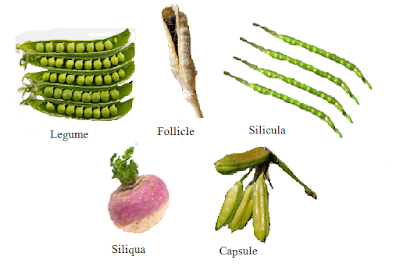Types of fruits
Different types of fruits are present. Some fruits are dry, some are succulent. These types are given
Simple fruits
Simple fruits
The fruits formed form the single flower with gynoecium (ovary) mono or poly carpellary and syncarpous is called simple fruits. These fruits are dry and succulent or fleshy. These are true fruits. Simple dry fruits These are dry fruits it has three types Achenial, Capsular and shizocarpic fruits. Achenial fruits The dry one seeded and indehisecent fruits are called achenial fruits. Their pericarp and testa is not rupute when they fall on the ground. The pericarp or testa rupute when they germinate. Achene The achenial fruits in which pericarp is membranous and free from seeds coat.Achene is drive from the monocarpellary pistal. It is occur in groups and from aggregate fruits. Example is Butter cup. Caryopsis The achenial fruits in which pericarp is fused is called caryopsis. This character is shown in different grasses like wheat, rice and corn. Nut The achenial fruits in which hard and woody pericarp form the shell is called nut.. Capule is formed by the fusion of the bracteoles. It example is Oak, lichi etc. Samara The achenial fruits in which pericarp is develop form a membrane outgrowth is called samara. Some time in growth is like a wing. This wing help the seed or fruit to travel long distance with wing. Example is elms.
Capsular fruits The dry many seeded and dihiscent fruits is called capsular fruit. Their pericarp is split and allows the seeds to escape. They have different forms and types. Follicle The fruits formed from the monocarpellary pistil and dehiscence along only one structure is called follical. Example Larkspur. Legume The fruits which are formed by monocarpellary pistil and dihiscene along both dorsal and ventral structures are called legume. Its example is pea bean. Siliqua A long cylindrical fruits formed by bicarpellary and syncarpous pistal with single ovary having two parital placentas is called siliqua. The ovary is uniclocular at first then it become multicular by formation of falls septum.Example is turnip , mustard. Silicula It is resemble with the siliqua but it is short and as long as broad and contains fewer seeds. Example Candy tuft. Capsule The fruits form ply capillary, syncarpous pistil with superior ovary is called capsule. Some time it formed from inferior ovary. Example Iris, willow. They have different dehiscence method.
By pores and by transverse method. By pores example is Campanula and by transverse splitting example is Hen bane.. By teeth example is pink.
Shizocarpic fruits The dry many seeded fruits which break into number of one seeded parts on ripening called shizocarpic. If these one seeded parts are indehiscent they are called mericarps. If they dihiscent they are called cocci. They are following shizocarpic fruits. Lomentum legume or pod modified by the formation of false septum and constrictions is called lomentum. It splits transversely at the constrictions. Example is Acacia arabica. Some member of Leguminous is also its examples. Double Samara The fruits which breaks up into two mericarps each containing one seed and wings is called double samara. It is derived from a bicarpellary pistil. Example of double samara is Maple. Cremocarp The fruits which is split into longitudinally between the loculi in to two one seeded mericarps is which remain attached to central axis carpohore. It is bicarpellary pistil derived. It has inferior and bilocular ovary. Example is coriander and fennel. Regma The fruits developed from the multilocular ovary with each single seed and having ripened fruit break up into a number of one seeded dehiscent parts called regama or cocci. This fruits develop from polycarpillary syncarpous pistil with superior multiocular ovary. Example of cocci and regama is Labiatae, Malvaceae and etc
By pores and by transverse method. By pores example is Campanula and by transverse splitting example is Hen bane.. By teeth example is pink.
Shizocarpic fruits The dry many seeded fruits which break into number of one seeded parts on ripening called shizocarpic. If these one seeded parts are indehiscent they are called mericarps. If they dihiscent they are called cocci. They are following shizocarpic fruits. Lomentum legume or pod modified by the formation of false septum and constrictions is called lomentum. It splits transversely at the constrictions. Example is Acacia arabica. Some member of Leguminous is also its examples. Double Samara The fruits which breaks up into two mericarps each containing one seed and wings is called double samara. It is derived from a bicarpellary pistil. Example of double samara is Maple. Cremocarp The fruits which is split into longitudinally between the loculi in to two one seeded mericarps is which remain attached to central axis carpohore. It is bicarpellary pistil derived. It has inferior and bilocular ovary. Example is coriander and fennel. Regma The fruits developed from the multilocular ovary with each single seed and having ripened fruit break up into a number of one seeded dehiscent parts called regama or cocci. This fruits develop from polycarpillary syncarpous pistil with superior multiocular ovary. Example of cocci and regama is Labiatae, Malvaceae and etc
Fruits have different forms and structure. Its seeds are present in side or out side with the help of these seeds fruits are grow and produce new generation. Some fruits are dry and some are succulent.



1 comments:
a root of Brassica napus as a siliqua???
and a cabbage as a cremocarp?
I admit ... I didn't read the text, but images say everything mate.
Post a Comment